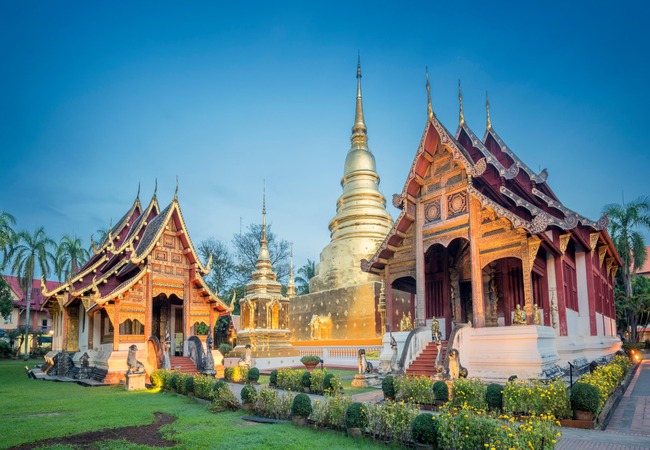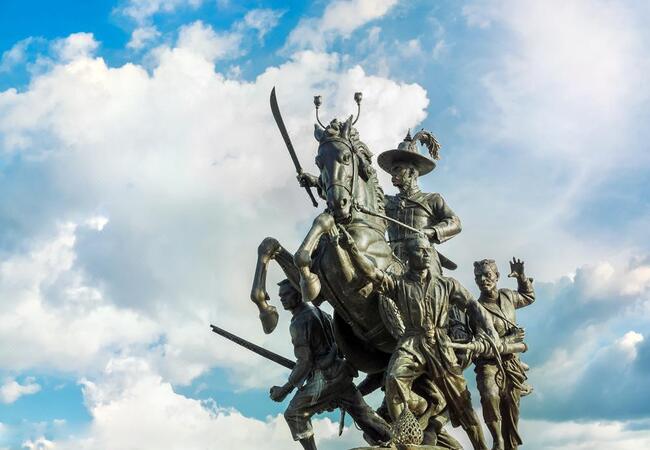I. Introduction
1. About Chiang Mai
Chiang Mai is a city located in the northern region of
Thailand, and it is known for its rich culture, beautiful temples, and stunning natural surroundings. The city has a history that dates back over 700 years, and it has been an important center of trade and commerce since its founding. Today, Chiang Mai is a popular destination for travelers from all over the world who are looking to experience the unique blend of ancient traditions and modern amenities that the city has to offer.
Natural Sign Around Chiang Mai
The city is home to a vibrant food scene, with a wide variety of dishes that are unique to the region, as well as many interesting cultural and historical sites that are worth exploring. Chiang Mai is also known for its beautiful natural surroundings, including national parks, waterfalls, and mountain ranges, which provide plenty of opportunities for outdoor activities such as hiking and mountain biking. With its rich history, unique culture, and stunning natural beauty, Chiang Mai is truly a destination that has something to offer everyone.
2. Understanding the history of Chiang Mai
Understanding the history of a destination is crucial for a deeper appreciation of its culture and traditions. It helps us gain insight into how a place evolved, what shaped its identity, and how it has developed over time. By learning about the history of a destination, we can better understand the local customs and traditions, as well as the social, political, and economic factors that have shaped the community. This knowledge can help us better appreciate the significance of the landmarks, monuments, and cultural events that we encounter while traveling.
Moreover, understanding the history of a destination can help us be more respectful and sensitive to the local people and their way of life. It can help us avoid cultural misunderstandings, and enable us to engage more meaningfully with the locals. Knowing the historical context of a destination can also deepen our empathy and appreciation for its people, and help us see the place from a different perspective.
In the case of Chiang Mai, learning about its history can give us a glimpse into its rich cultural heritage and diverse ethnic communities. It can help us understand how the city became the center of Lanna culture and a melting pot of Thai, Burmese, and Chinese influences. Additionally, knowing the city's history can help us appreciate the significance of its ancient temples, historic city walls, and traditional festivals. Overall, understanding the history of a destination is an essential part of responsible travel and can enrich our travel experience in numerous ways.
II. Early History of Chiang Mai
Chiang Mai, located in Northern Thailand, is a city with a rich and fascinating history that dates back over 700 years. The city has seen numerous changes over the centuries, from its establishment to its prominence in the Lanna Kingdom and its subsequent annexation by the Thai state. Understanding the early history of Chiang Mai is crucial to understanding the city's culture, traditions, and architecture.
1. Founding of Chiang Mai
The city of Chiang Mai was founded in 1296 by King Mengrai, who unified the Tai-speaking people in the region and established the city as the capital of the newly-formed Lanna Kingdom. The city was strategically located at the junction of important trade routes, which helped it become a center of commerce and culture.
2. Establishment of the Lanna Kingdom

Temples from Lanna Era
The Lanna Kingdom, meaning "a million rice fields" in Tai, was established by King Mengrai and lasted until the 16th century. During this time, Chiang Mai flourished as a center for art, religion, and scholarship. The kingdom was known for its distinctive architecture, which incorporated elements of traditional Lanna style with influences from neighboring kingdoms such as Myanmar and China. The city was also home to a number of important temples, including Wat Chiang Man, the oldest temple in Chiang Mai, and Wat Phra Singh, which was built in the 14th century and is still considered one of the city's most important religious sites.
3. Relationship with Neighboring Kingdoms
Throughout its history, Chiang Mai has had close ties with neighboring kingdoms, including Myanmar and China. The city's location at the crossroads of important trade routes made it an important center for commerce, and the rulers of the Lanna Kingdom established diplomatic and trade relationships with their counterparts in neighboring states. These relationships were often complex and sometimes fraught with tension, as kingdoms vied for power and influence in the region.
In the late 16th century, the Lanna Kingdom was annexed by the Thai state, and Chiang Mai became a provincial capital. Despite this, the city continued to thrive as a cultural and religious center, with important temples and shrines attracting pilgrims from throughout the region. The city's architecture also continued to evolve, with the influence of the Thai state and other neighboring kingdoms becoming more prominent.
Today, Chiang Mai is a vibrant and dynamic city that blends traditional Lanna culture with modern amenities and attractions. The city's history can be seen in its ancient temples and architecture, as well as in its vibrant markets and festivals that celebrate the region's rich cultural heritage. By learning about the early history of Chiang Mai, visitors can gain a deeper appreciation for the city's unique character and its place in the wider cultural and historical landscape of Thailand and Southeast Asia.
III. Chiang Mai During the Burmese Occupation
1. The Burmese invasion of Chiang Mai
During the Burmese occupation, Chiang Mai experienced a period of great turmoil and hardship. In 1558, the Burmese invaded and conquered Chiang Mai, bringing an end to the rule of the Lanna Kingdom. The Burmese occupation of Chiang Mai lasted for over two centuries and had a significant impact on the city's culture and development.
Under Burmese rule, Chiang Mai was heavily taxed and the people were forced into slavery. The Burmese also destroyed many of the city's temples and cultural landmarks, including the famous Wat Chedi Luang. Despite these hardships, the people of Chiang Mai managed to maintain their identity and culture.
2. The liberation of Chiang Mai by King Taksin

King Taksin
In 1774, King Taksin of Thonburi launched a campaign to liberate Chiang Mai from Burmese rule. The liberation of Chiang Mai was a long and difficult process, lasting over a year. In 1775, King Taksin and his army finally succeeded in freeing Chiang Mai from Burmese occupation.
The liberation of Chiang Mai was a turning point in the city's history. Under King Taksin's rule, Chiang Mai was rebuilt and revitalized. Many of the city's temples and cultural landmarks were restored, including the famous Wat Chedi Luang. The people of Chiang Mai were able to resume their way of life and rebuild their city.
3. The occupation and its impact on Chiang Mai
Today, the impact of the Burmese occupation can still be seen in Chiang Mai's culture and traditions. The city's cuisine, for example, features many dishes that are influenced by Burmese flavors and ingredients. The Burmese occupation also helped to shape Chiang Mai's unique architecture and artistic style.
Despite the hardships of the Burmese occupation, the people of Chiang Mai were able to preserve their culture and identity. The liberation of Chiang Mai by King Taksin was a pivotal moment in the city's history and helped to shape its identity as a vibrant and resilient cultural center.
IV. Chiang Mai under Siamese Control
1. Integration into the Siamese Kingdom
Under Siamese control, Chiang Mai continued to thrive economically and culturally, with the city becoming a hub for trade in Southeast Asia. The abundance of natural resources in the region, such as teak and other hardwoods, helped drive the growth of the city's economy. Chiang Mai's location on the trade routes connecting China, Burma, and Siam also played a significant role in its economic success.
2. The growth of Chiang Mai's cultural and economic significance
During this time, Chiang Mai also saw a rise in the popularity of Buddhism, which became a significant part of the city's cultural identity. Temples and monasteries were built throughout the city, with the most famous being Wat Phra Singh, Wat Chedi Luang, and Wat Chiang Man. These temples continue to be some of the most visited attractions in Chiang Mai, attracting visitors from all over the world.
The Ruins of Siamese Kingdom
In addition to the religious and cultural significance of the city, Chiang Mai also played an important role in the development of the arts and crafts of Northern Thailand. The city became a center for the production of textiles, ceramics, and other handicrafts, with many of these items being sold throughout the region.
The growth of Chiang Mai's economy and cultural significance continued throughout the 19th and 20th centuries. In the late 19th century, the construction of the Northern Railway brought more prosperity to the city, making it even easier to transport goods throughout the region. In the early 20th century, Chiang Mai saw significant growth in the tourism industry, with visitors coming to explore the city's rich history and cultural heritage.
V. Chiang Mai in the Modern Era
1. Impact of the 1932 Siamese Revolution
Chiang Mai, like many other parts of Thailand, underwent significant changes during the 20th century. The period of modernization began with the 1932 Siamese Revolution, which resulted in the end of absolute monarchy and the establishment of a constitutional government. Chiang Mai was no longer a separate province, but became a part of the larger Chiang Mai Province under the new administration.
2. Chiang Mai during World War II
During World War II, Chiang Mai was occupied by the Japanese forces and became a hub for military activities. The city also played a role in the Allied forces' war efforts, with the US establishing a base in the city. After the war, Chiang Mai was once again under the control of the Thai government, and its economy began to recover.
3. Contemporary developments and challenges
In the decades that followed, Chiang Mai continued to grow and develop. The city's cultural and economic significance increased, with the growth of the tourism industry and the establishment of new businesses. However, this growth has also brought challenges, such as urbanization, environmental issues, and social inequality.
One of the most significant challenges facing modern-day Chiang Mai is the issue of air pollution. The city experiences high levels of air pollution during the dry season, which can have serious health consequences for residents and visitors alike. Efforts are being made to address this issue, such as the implementation of air-quality monitoring systems and the promotion of sustainable transportation options.
VI. Final Words
Chiang Mai's history is one that is rich and diverse, reflecting the many cultural influences that have shaped this vibrant city. From its founding as a regional capital to its modern status as a major cultural and economic hub, Chiang Mai has a long and fascinating history that is worth exploring.
Chiang Mai's history is a testament to the resilience and creativity of its people. From the ancient Lanna Kingdom to the modern city of today, Chiang Mai has faced many challenges, but it has always managed to overcome them with grace and determination. By exploring the city's rich heritage, visitors can gain a deeper understanding of the forces that have shaped this fascinating and beautiful place, and come away with a renewed appreciation for the spirit of Chiang Mai.